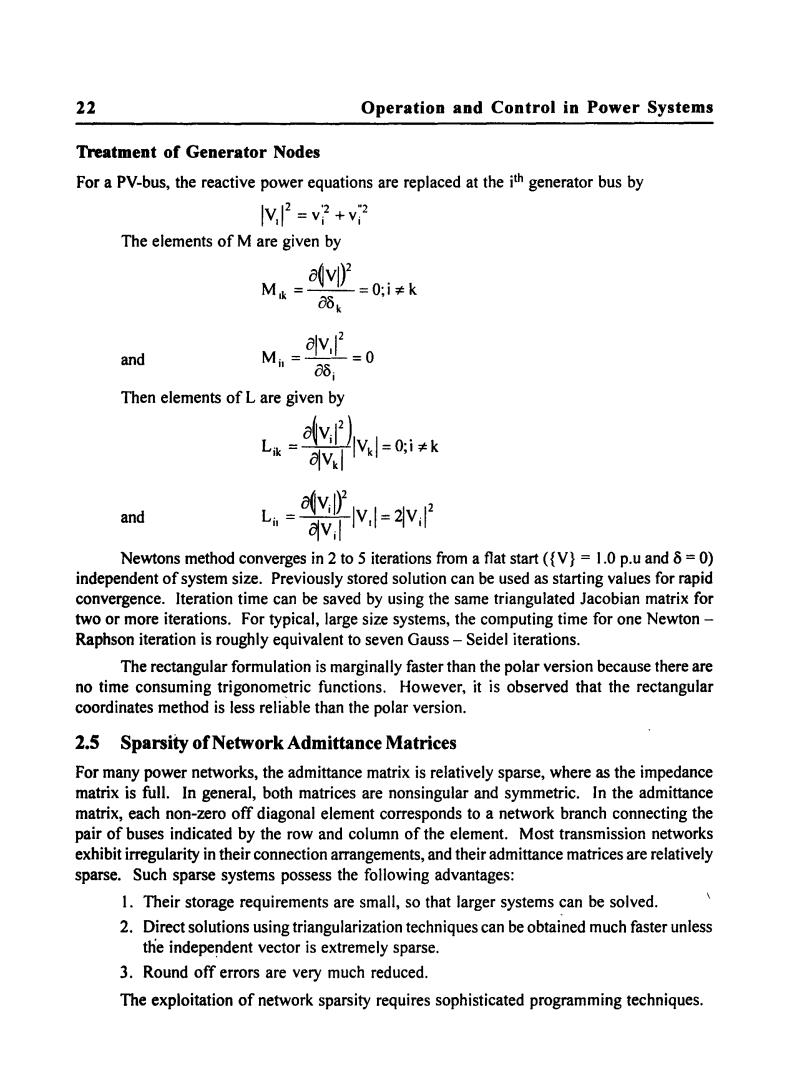
22 Operation and Control in Power Systems Treatment of Generator Nodes For a PV-bus,the reactive power equations are replaced at the ith generator bus by N,2=2+v2 The elements of M are given by Mx= =0:i≠k 08k and Mi av-o a81 Then elements of L are given by and Li= v-2w av; Newtons method converges in 2 to 5 iterations from a flat start ({V)=1.0 p.u and 8=0) independent of system size.Previously stored solution can be used as starting values for rapid convergence.Iteration time can be saved by using the same triangulated Jacobian matrix for two or more iterations.For typical,large size systems,the computing time for one Newton- Raphson iteration is roughly equivalent to seven Gauss-Seidel iterations. The rectangular formulation is marginally faster than the polar version because there are no time consuming trigonometric functions.However,it is observed that the rectangular coordinates method is less reliable than the polar version. 2.5 Sparsity of Network Admittance Matrices For many power networks,the admittance matrix is relatively sparse,where as the impedance matrix is full.In general,both matrices are nonsingular and symmetric.In the admittance matrix,each non-zero off diagonal element corresponds to a network branch connecting the pair of buses indicated by the row and column of the element.Most transmission networks exhibit irregularity in their connection arrangements,and their admittance matrices are relatively sparse.Such sparse systems possess the following advantages: 1.Their storage requirements are small,so that larger systems can be solved. 2.Direct solutions using triangularization techniques can be obtained much faster unless the independent vector is extremely sparse. 3.Round off errors are very much reduced. The exploitation of network sparsity requires sophisticated programming techniques
22 Operation and Control in Power Systems Treatment of Generator Nodes For a PV-bus, the reactive power equations are replaced at the ith generator bus by I 1 2 '2 "2 VI =vj +Vj The elements of M are given by a~vlY . M k = --= 0'1'* k I aO k ' and Then elements of L are given by afty. 12) L· = q I Iv 1= O·j '* k Ik alvkl k , and a~VjlY 2 Lj, = ~Vd IV,I = 21 Vd Newtons method converges in 2 to 5 iterations from a flat start ( {V} = 1.0 p.u and 0 = 0) independent of system size. Previously stored solution can be used as starting values for rapid convergence. Iteration time can be saved by using the same triangulated Jacobian matrix for two or more iterations. For typical, large size systems, the computing time for one Newton - Raphson iteration is roughly equivalent to seven Gauss - Seidel iterations. The rectangular formulation is marginally faster than the polar version because there are no time consuming trigonometric functions. However, it is observed that the rectangular coordinates method is less reliable than the polar version. 2.5 Sparsity of Network Admittance Matrices For many power networks, the admittance matrix is relatively sparse, where as the impedance matrix is full. In general, both matrices are nonsingular and symmetric. In the admittance matrix, each non-zero off diagonal element corresponds to a network branch connecting the pair of buses indicated by the row and column of the element. Most transmission networks exhibit irregularity in their connection arrangements, and their admittance matrices are relatively sparse. Such sparse systems possess the following advantages: I. Their storage requirements are small, so that larger systems can be solved. 2. Direct solutions using triangularization techniques can be obtained much faster unless the independent vector is extremely sparse. 3. Round off errors are very much reduced. The exploitation of network sparsity requires sophisticated programming techniques
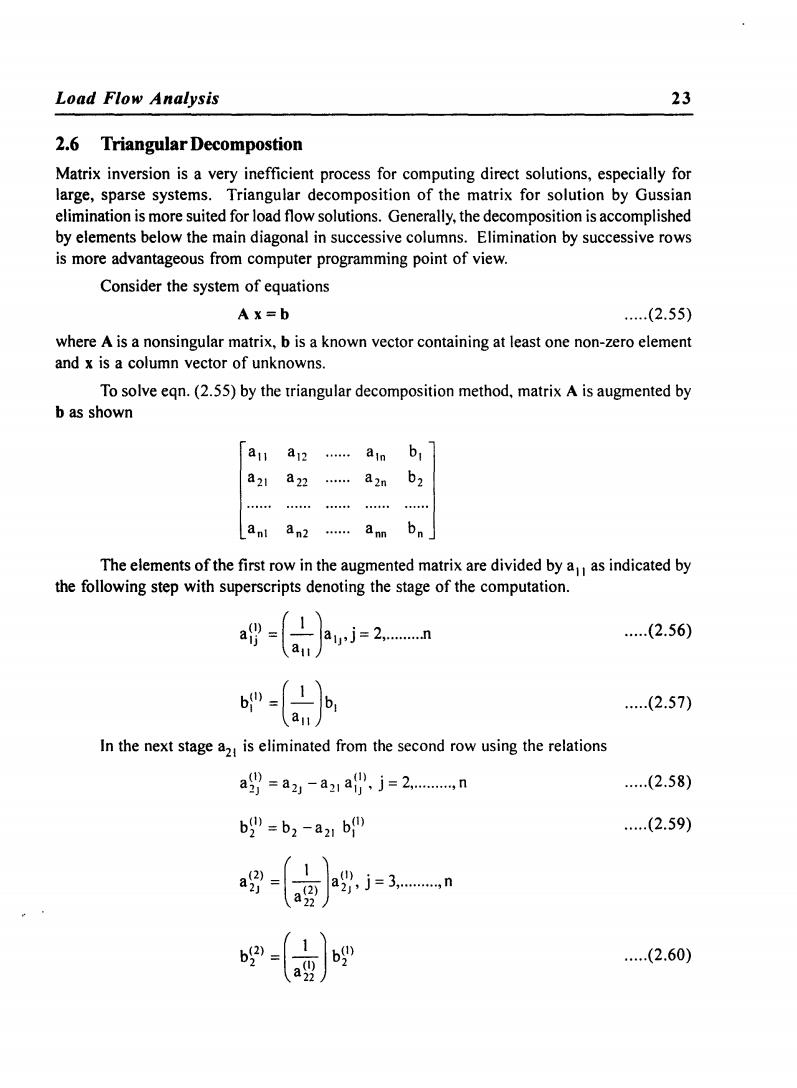
Load Flow Analysis 23 2.6 Triangular Decompostion Matrix inversion is a very inefficient process for computing direct solutions,especially for large,sparse systems.Triangular decomposition of the matrix for solution by Gussian elimination is more suited for load flow solutions.Generally,the decomposition is accomplished by elements below the main diagonal in successive columns.Elimination by successive rows is more advantageous from computer programming point of view. Consider the system of equations Ax=b ..(2.55) where A is a nonsingular matrix,b is a known vector containing at least one non-zero element and x is a column vector of unknowns. To solve eqn.(2.55)by the triangular decomposition method,matrix A is augmented by b as shown a11 a12 ain a21 a22 a2n b2 anl an2… ann bn] The elements of the first row in the augmented matrix are divided by a as indicated by the following step with superscripts denoting the stage of the computation. aj=2... ..(2.56) a …(2.57) In the next stage az is eliminated from the second row using the relations a=a2-aj2....n .(2.58) b"=b2-a21b" .(2.59) a.j=3,n b= 1 b) (2.60)
Load Flow Analysis 23 2.6 Triangular Decompostion Matrix inversion is a very inefficient process for computing direct solutions, especially for large, sparse systems. Triangular decomposition of the matrix for solution by Gussian elimination is more suited for load flow solutions. Generally, the decomposition is accomplished by elements below the main diagonal in successive columns. Elimination by successive rows is more advantageous from computer programming point of view. Consider the system of equations Ax=b ..... (2.55) where A is a nonsingular matrix, b is a known vector containing at least one non-zero element and x is a column vector of unknowns. To solve eqn. (2.55) by the triangular decomposition method, matrix A is augmented by b as shown [ ~.::. a l2 a ln ·:':··1 a 22 a 2n anI a n2 ann bn The elements of the first row in the augmented matrix are divided by all as indicated by the following step with superscripts denoting the stage of the computation. a(I) - ( 1 J '- lj - - alJ'J - 2, ......... n all ..... {2.56) bll)=(_IJbl all ..... (2.57) In the next stage a21 is eliminated from the second row using the relations (I) (I) . 2 a 2) = a 2) -a 21 a l ), J = , ......... ,n ..... (2.58) b(l) - b -a b(1) 2 - 2 21 I ..... (2.59) (2) (1 ) (1) • a 2) = m a 2j , J = 3, ......... , n a22 b(2) = (_1_) b(l) 2 (I) 2 a 22 ..... (2.60)
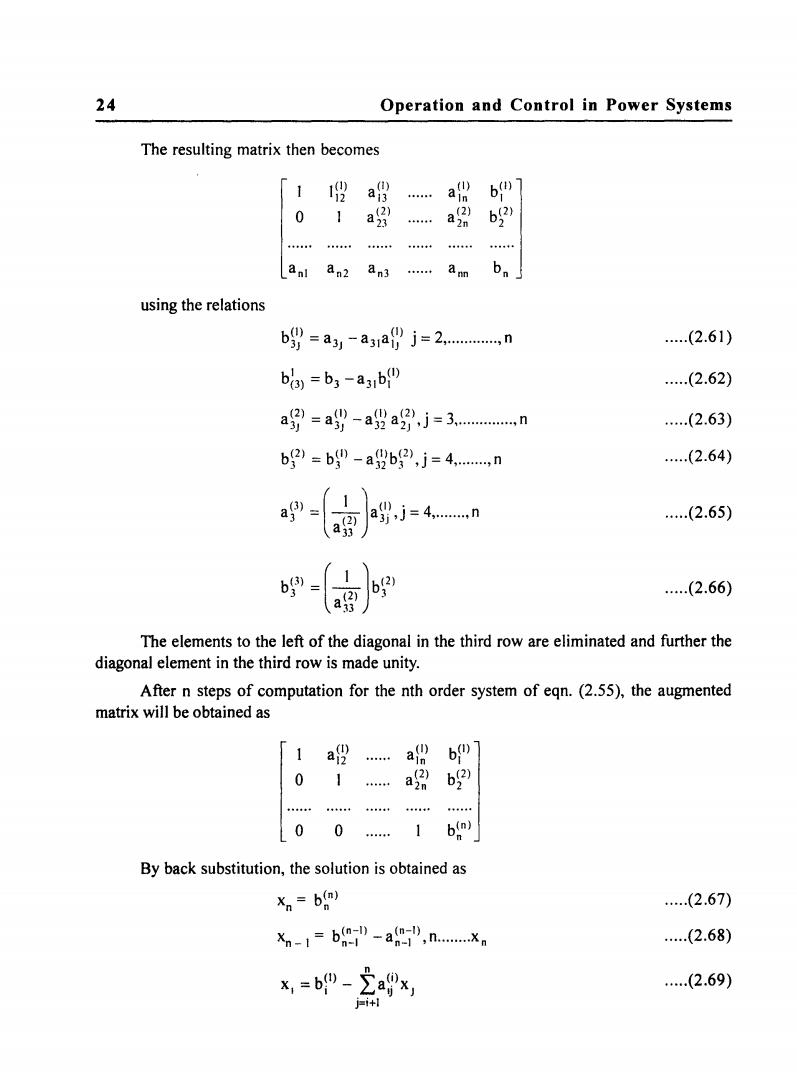
24 Operation and Control in Power Systems The resulting matrix then becomes 1 侣 44* a b07 0 a b2) anl an2 an3 b using the relations bg=a3-aa=2. .(2.61) b)=b3-a3ib .(2.62) ag=agag agj3...... .(2.63) b2=b9-a毁bg2,j=4,n ..(2.64) a a a,j=4…n .(2.65) b (2) ..(2.66) The elements to the left of the diagonal in the third row are eliminated and further the diagonal element in the third row is made unity. After n steps of computation for the nth order system of eqn.(2.55),the augmented matrix will be obtained as a a ba) 0 绍 b2) 0 0 年n4 1 b By back substitution,the solution is obtained as Xn=b(m) .(2.67) X-1=ba-a,nx。 ..(2.68) x,=b9- .(2.69)
24 Operation and Control in Power Systems The resulting matrix then becomes I 1(1) 12 a(l) 13 a(l) In b(l) I 0 I a (2) 23 a(2) 2n b(2) 2 ani an2 an3 ann bn using the relations b(J) - (I) . - 2 3) - a 3) - a3l a l ) J - , ............ , n bl b b(l) (3)= 3- a31 I (2) _ (I) (I) (2) • - 3 a 3) - a3) -a32 a2) ,J - , ............. ,n b(2) - b(l) (I)b(2)' - 4 3 - 3 -a32 3 ,J- , ....... ,n (3) - ( I 1 (I) '- a 3 - a(2) a3j ,J - 4, ....... ,n 33 ..... (2.61 ) ..... (2.62) ..... (2.63) ..... (2.64 ) ..... (2.65) ..... (2.66) The elements to the left of the diagonal in the third row are eliminated and further the diagonal element in the third row is made unity. After n steps of computation for the nth order system of eqn. (2.55), the augmented matrix will be obtained as a(l) 12 o I o o By back substitution, the solution is obtained as x = ben) n n - b(n-I) (n-I) xn _ l - n-I -an_I ,n ........ xn ..... (2.67) ..... (2.68) ..... (2.69)
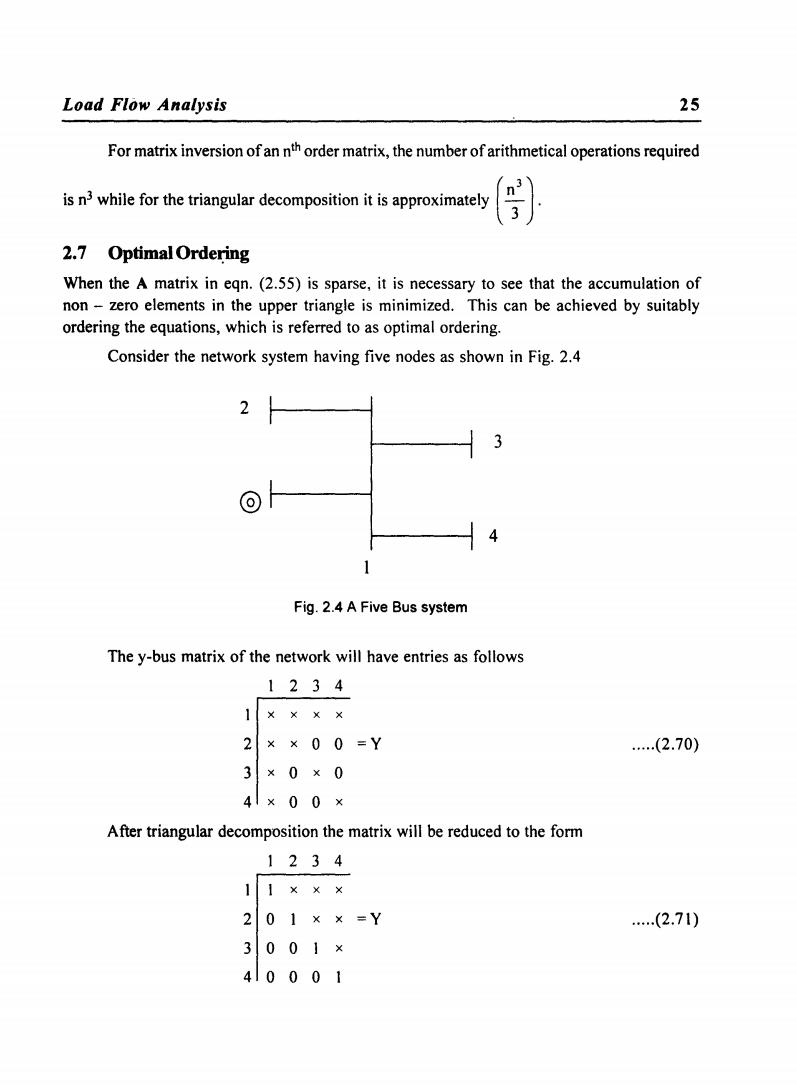
Load Flow Analysis 25 For matrix inversion of an nth order matrix,the number of arithmetical operations required is n3 while for the triangular decomposition it is approximately 3 2.7 Optimal Ordering When the A matrix in eqn.(2.55)is sparse,it is necessary to see that the accumulation of non-zero elements in the upper triangle is minimized.This can be achieved by suitably ordering the equations,which is referred to as optimal ordering. Consider the network system having five nodes as shown in Fig.2.4 2 3 Fig.2.4 A Five Bus system The y-bus matrix of the network will have entries as follows 1234 1×××× 2××00=Y …(2.70) 3×0×0 41×00× After triangular decomposition the matrix will be reduced to the form 1234 11××× 201××=Y …(2.71) 3001× 410001
Load Flow Analysis 25 For matrix inversion of an nth order matrix, the number of arithmetical operations required is n3 while for the triangular decomposition it is approximately (n; ) . 2.7 Optimal Orde~g When the A matrix in eqn. (2.55) is sparse, it is necessary to see that the accumulation of non - zero elements in the upper triangle is minimized. This can be achieved by suitably ordering the equations, which is referred to as optimal ordering. Consider the network system having five nodes as shown in Fig. 2.4 3 4 Fig. 2.4 A Five Bus system The y-bus matrix of the network will have entries as follows 2 3 4 x x x x 2 x x 0 0 =y 3 x 0 x 0 4 x 0 0 x After triangular decomposition the matrix will be reduced to the form 234 x x x 2 0 x x =y 300 1 x 4 000 ..... (2.70) ..... (2.71)
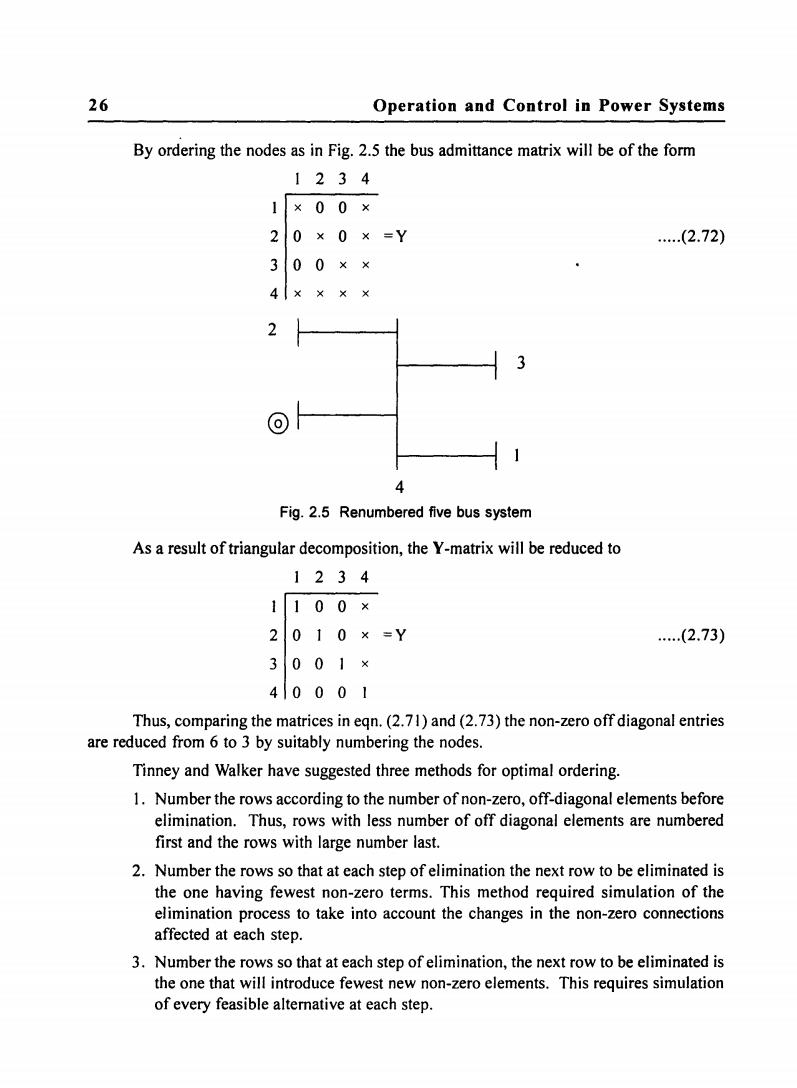
26 Operation and Control in Power Systems By ordering the nodes as in Fig.2.5 the bus admittance matrix will be of the form 1234 1×00× 20×0×=Y (2.72) 300×× 4「×××× 2 4 Fig.2.5 Renumbered five bus system As a result of triangular decomposition,the Y-matrix will be reduced to 1234 1100× 2010×=Y .(2.73) 3001× 410001 Thus,comparing the matrices in eqn.(2.71)and(2.73)the non-zero off diagonal entries are reduced from 6 to 3 by suitably numbering the nodes. Tinney and Walker have suggested three methods for optimal ordering 1.Number the rows according to the number of non-zero,off-diagonal elements before elimination.Thus,rows with less number of off diagonal elements are numbered first and the rows with large number last. 2.Number the rows so that at each step of elimination the next row to be eliminated is the one having fewest non-zero terms.This method required simulation of the elimination process to take into account the changes in the non-zero connections affected at each step. 3.Number the rows so that at each step of elimination,the next row to be eliminated is the one that will introduce fewest new non-zero elements.This requires simulation of every feasible alternative at each step
26 Operation and Control in Power Systems By ordering the nodes as in Fig. 2.5 the bus admittance matrix will be of the form 2 3 4 x 0 0 x 2 0 x 0 x =Y 3 0 0 x x 4 x x x x 2 3 @ 4 Fig. 2.5 Renumbered five bus system As a result of triangular decomposition, the V-matrix will be reduced to 234 o 0 x 2 0 o x =Y 300 x 400 0 ..... (2.72) ..... (2.73) Thus, comparing the matrices in eqn. (2.71) and (2.73) the non-zero off diagonal entries are reduced from 6 to 3 by suitably numbering the nodes. Tinney and Walker have suggested three methods for optimal ordering. 1. Number the rows according to the number of non-zero, off-diagonal elements before elimination. Thus, rows with less number of off diagonal elements are numbered first and the rows with large number last. 2. Number the rows so that at each step of elimination the next row to be eliminated is the one having fewest non-zero terms. This method required simulation of the elimination process to take into account the changes in the non-zero connections affected at each step. 3. Number the rows so that at each step of elimination, the next row to be eliminated is the one that will introduce fewest new non-zero elements. This requires simulation of every feasible alternative at each step